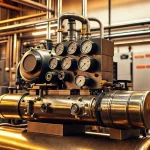Overhead cranes play a vital role across industries, yet traditional designs often leave safety margins to chance. Recent advancements integrate automation, digital monitoring, and intelligent engineering to drastically reduce human error and prevent accidents. By reimagining crane architecture and embedding advanced safety features, these innovations set new benchmarks for lifting security and operational reliability paving the way for safer workplaces and more efficient material handling on a global scale.
Latest Innovations in Overhead Crane Design
Advancing safety and efficiency through smart engineering
Also to discover : Maximize savings with commercial solar panels for your business
Recent overhead crane advancements have focused heavily on integrating cutting-edge safety technology in cranes, significantly improving operational security and reliability. One major breakthrough is the incorporation of automated load sensors that continuously monitor weight distribution, preventing overload situations that could cause accidents. These sensors communicate in real-time with digital monitoring systems, alerting operators to potential hazards before they escalate.
Automation has transformed crane operation by minimizing the need for manual control, thereby reducing human error a primary cause of crane-related incidents. Modern cranes feature intelligent control systems that optimize movement pathways and implement automatic emergency stops when irregularities are detected. This seamless integration of crane engineering updates not only enhances safety but also boosts productivity by streamlining lifting processes.
Also to read : Unlock business savings through efficient commercial solar solutions
Furthermore, intelligent design innovations incorporate user-friendly interfaces and predictive maintenance alerts, enabling proactive servicing and minimizing downtime. As a result, the overall lifecycle and reliability of overhead cranes have improved, ensuring safer lifting environments across industries. Accessing expertise from firms like Smithwick Engineering shows how these technological advancements are setting new standards in crane safety and engineering excellence.
Enhanced Safety Features in Modern Overhead Cranes
Modern overhead cranes incorporate a variety of advanced crane safety features designed to minimize risk and enhance operational security. One crucial element is the integration of anti-collision systems. These systems use proximity sensors to detect nearby obstacles, preventing crane collisions with structures, equipment, or personnel. By continuously monitoring the crane’s environment, anti-collision technology significantly reduces accidents and damage.
Load monitoring plays a pivotal role in crane safety modifications. Sophisticated sensors measure the weight of the load in real time, ensuring it does not exceed the crane’s rated capacity. This prevents dangerous overload conditions and protects both the crane and operators from mechanical failure risks. Additionally, automated overload protection algorithms halt operations if an unsafe load is detected, further safeguarding equipment and staff.
Fail-safe mechanisms, including emergency stop technologies, are fundamental in overhead crane safety. These features immediately stop the crane in case of an emergency or system malfunction, allowing for rapid response to potential hazards. Modern cranes also incorporate redundant braking systems to maintain control if primary brakes fail, ensuring a robust safety net throughout operations.
Emphasizing these advanced crane safety features not only enhances reliability but also aligns with industry standards for safe lifting practices. For more on innovative engineering improving crane safety, see Smithwick Engineering.
Adapting Crane Design to Meet Evolving Safety Standards
Safety in crane operations depends heavily on adherence to crane safety regulations that vary across global and regional landscapes. Manufacturers and engineers must navigate a complex web of rules established by authorities such as OSHA in the United States, the European Union Machinery Directive, and other regional bodies. These regulations set minimum requirements designed to prevent accidents and ensure the safety of both operators and nearby workers.
Industry engineering standards significantly influence crane design, dictating parameters such as load capacities, structural integrity, and control systems. Standards set by organizations such as the American Society of Mechanical Engineers (ASME) and the International Organization for Standardization (ISO) serve as benchmarks for safety and quality. They prescribe testing procedures, materials, and design methodologies that help prevent failures, ensuring equipment performs reliably under various operational conditions.
Continual compliance in lifting equipment requires manufacturers and operators to maintain certifications and conduct regular inspections. This ongoing process ensures cranes stay within approved safety margins throughout their service life. Certificates like the Crane Inspection Certification demonstrate that equipment complies with the latest safety standards, helping companies avoid legal liabilities and operational downtime.
Case Studies: Real-World Applications of Safer Crane Designs
Exploring case studies crane safety reveals a compelling pattern: integrating advanced technologies and design improvements significantly cuts down accidents in industrial environments. For example, several success stories overhead cranes demonstrate how modern control systems and precise engineering have enhanced operational safety. These case studies highlight measurable reductions in downtime and injury rates, proving the practical value of upgrading crane safety features.
When comparing traditional crane designs with contemporary models, it becomes clear that the latter incorporate critical safety enhancements such as automated load monitoring, emergency stop functions, and fail-safe braking systems. These improvements contribute to more predictable and controlled lifting operations. A practical safety improvement often cited is the reinforced trolley and hoist structures, which better withstand wear and reduce the likelihood of mechanical failures.
Lessons learned from these case studies include the importance of regular maintenance schedules, operator training tailored to new technologies, and incorporating feedback loops between design engineers and end users. Such best practices ensure that safety advancements are not just theoretical but become integral to daily operations. Organizations seeking to implement similar solutions may find additional insights in resources like Smithwick Engineering, known for revolutionizing overhead crane engineering for safer lifting, to deepen their understanding of innovative safety design.
Considerations for Future Crane Design Enhancements
Advancements in future crane technologies are set to transform lifting operations by incorporating more sophisticated predictive safety analytics. These systems analyze operational data in real-time, identifying patterns that may signal potential issues before they escalate into unsafe conditions. This proactive approach enables maintenance teams to intervene early, dramatically reducing the risk of accidents and improving overall operational reliability.
In addition to analytics, design innovation in lifting equipment is increasingly focused on integrating cutting-edge materials science. Utilizing lighter yet stronger materials enhances cranes’ load capacity and durability while simultaneously reducing their environmental footprint. Structural redesigns that emphasize modular components also facilitate easier upgrades and repairs, ensuring longevity and adaptability of crane systems.
The integration of these technologies will have a profound long-term impact on workplace safety culture, fostering an environment where safety is embedded into every phase of crane operation. By combining intelligent monitoring with next-generation materials and thoughtful engineering, future cranes will set new safety benchmarks and improve efficiency, affirming the industry’s commitment to protecting workers and assets alike.











